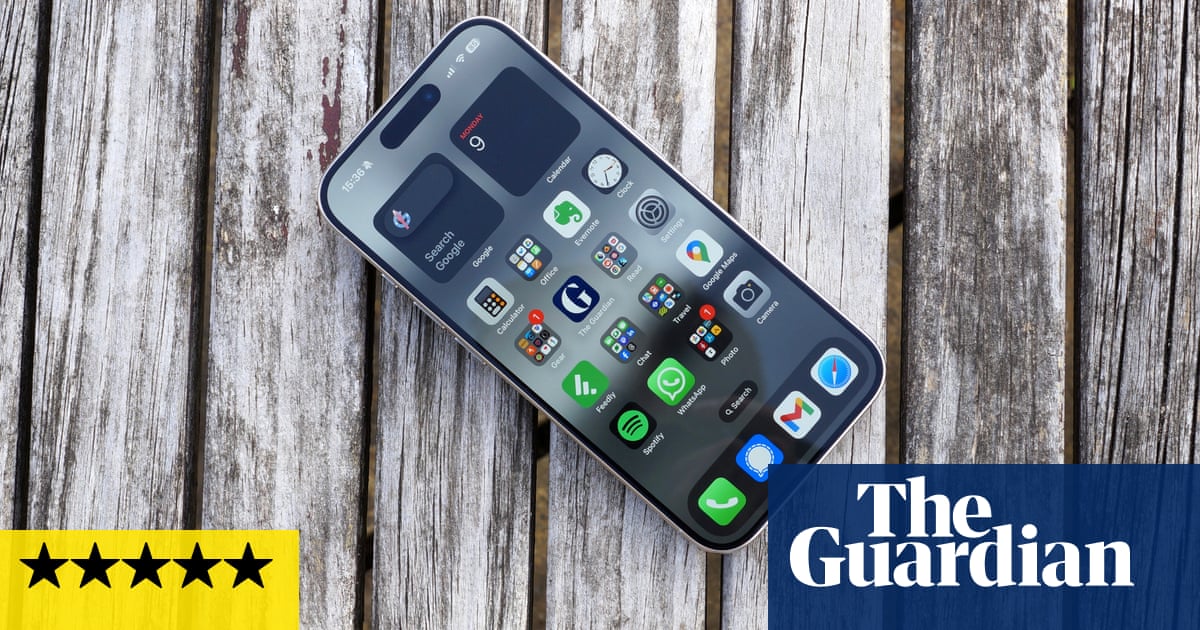
pple’s more luxurious version of the iPhone 12 takes the best of the iPhone 4’s looks, adds some polished stainless steel and a third camera on the back – and an extra £200 to the price.
The new iPhone 12 Pro costs from £999 and sits between the slightly smaller £699 12 Mini, the same-size £799 12 and the larger, more expensive £1,099 12 Pro Max, which will have a more powerful camera when launched on 13 November.
In many ways it is the awkward middle child. The iPhone 12 Pro is the same size with the same revamped design and essentially the same features as the iPhone 12. But instead of aluminium sides the 12 Pro has a stainless steel body with highly polished sides.
It is also 25g heavier than the standard 12, which makes it relatively heavy at 187g compared with similarly sized and specced competitors, and slightly harder to hold as a result. It is only 0.1mm wider than its 11 Pro predecessor, which had a smaller 5.8in screen.
The screen is the same stunning 6.1in OLED display as in the iPhone 12, but is slightly brighter on the 12 Pro. It is also covered by Apple’s new more drop-resistant “Ceramic Shield” material, and has the MagSafe charging and accessory system built into its back.
Specifications
Screen: 6.1in Super Retina XDR (OLED) (460ppi)
Processor: Apple A14 Bionic
RAM: 6GB
Storage: 128, 256 or 512GB
Operating system: iOS 14
Camera: triple 12MP rear cameras with lidar, 12MP front-facing camera
Connectivity: LTE, wifi 6, NFC, Bluetooth 5, lightning, ultra wideband and GPS
Water resistance: IP68 (6 metres for 30 mins)
Dimensions: 146.7mm x 71.5mm x 7.4mm
Weight: 187g
Long battery life with top performance
The iPhone 12 Pro has the same A14 Bionic processor as the iPhone 12 and iPad Air, but with 6GB of RAM instead of just 4GB and with a starting storage of 128GB – double the 12’s 64GB. Performance is equally excellent all round: snappy, slick and fast to process photos, videos or when playing games.
5G performance is the same as the iPhone 12, too: speeds match the competition but indoor 5G reception is slightly worse than the OnePlus 8T or Samsung Galaxy Z Fold 2. It has little impact on battery outside of intensive testing.
Battery life is excellent and the phone lasts about 40 hours between charges with the screen used for apps and video for well over six hours in that time, which is similar to the iPhone 12 and longer than most of the competition. That means the phone will last from 7am on day one until the evening of day two with normal use – including four hours on 5G.
It takes 25 minutes to charge the battery to 50% but just under two hours for a full charge using a £19 Apple 20W USB-C charger – no power adapter is included in the box, just a USB-C to Lightning cable. The charge rate drops significantly beyond 95%, which is reached in less than 90 minutes. Fully charging using Apple’s new MagSafe wireless charger takes more than three hours connected to the same 20W USB-C charger.
Sustainability
Apple does not provide an expected lifespan for the iPhone 12 Pro’s battery, but it can be replaced for £69. The typical lifespan of a smartphone battery is at least 500 cycles while maintaining at least 80% capacity. The smartphone is generally repairable, with an out-of-warranty service costing £526.44 which includes the screen. The iPhone 12 Pro was awarded six out of 10 for repairability by the specialist iFixit.
The iPhone 12 Pro uses 100% recycled tin in the solder of its main board, 99% recycled tungsten, 98% recycled rare earth elements and at least 35% recycled plastic in multiple other components. Apple is also using renewable energy for final assembly of the handset and breaks down the phone’s environmental impact in its report.
Apple offers trade-in and free recycling schemes, including for non-Apple products. The iPhone 12 Pro does not ship with headphones or a power adapter in the box, just a USB-C to Lightning cable, reducing its carbon footprint.
iOS 14
The 12 Pro ships with the same iOS 14.1 version as the iPhone 12, including the home screen visual overhaul with widgets and the App Library folders, enhanced privacy tools and the new Translate app.
You can expect upwards of five years of software support including security fixes and iOS version updates once a year in line with all other iPhones, which is longer than any other manufacturer of smartphones.
Camera
The iPhone 12 Pro has a triple 12-megapixel camera system on the rear and a single 12-megapixel selfie camera on the front. Two of the rear cameras, the main and ultrawide, as well as the selfie camera are identical to those on the iPhone 12 and perform the same, including solid improvements to low-light performance, detail and noise control.
The third camera on the back is a 2x telephoto camera, enabling the iPhone 12 Pro to optically zoom from 0.5 to 2x and then on to 10x digital zoom. The telephoto camera can produce some great images and any optical zoom is better than pure digital zoom. But having only a two-times magnification means it cannot bring you that much closer to your subject, particularly compared with rivals with 3x, 4x or 5x optical zoom cameras.
The other addition to the 12 Pro is a lidar (light detection and ranging) scanner on the back. It measures the distance to objects, working in a similar way to that fitted to the iPad Pro to scan a room for enhanced augmented reality (AR) experiences. But for the camera it aids autofocus in the dark, enabling much faster focusing in low light and Night mode portrait shots, which uses the main camera and the depth sensor for some impressive photos of people.
One area where Apple is very much ahead of the pack is in video. On top of the excellent video shot by the iPhone 12, the 12 Pro has the extra zoom and can capture video in Dolby Vision HDR recording in 4K at 60 frames a second, where the iPhone 12 is restricted to 30fps.
Note that the larger iPhone 12 Pro Max has a larger sensor and an improved type of optical image stabilisation technology on its main camera and a longer 2.5x telephoto camera; those looking for the best camera on an iPhone will want to wait.
Both 12 Pro phones will also be able to shoot in a new Apple ProRAW format after an update. The ProRAW files combine Apple’s computational photography system with the capabilities of a traditional RAW format for professional and enthusiast photographers to change the various parameters and choices made by the camera after the fact.
Observations
The frosted glass back of the 12 Pro is more slippery than the glossy glass one on the iPhone 12.
Price
The iPhone 12 Pro costs £999 for 128GB, £1,099 for 256GB or £1,299 for 512GB of storage.
In comparison, the iPhone 12 Pro Max costs from £1,099, the iPhone 12 costs £799, the iPhone 12 Mini costs £699 and the iPhone SE costs £399. The Samsung Galaxy S20 costs £899, the Google Pixel 5 costs £599 and the OnePlus 8T costs £549.
Verdict
The iPhone 12 Pro is good phone, but one that’s stuck between a really great one and a potentially even better one in Apple’s 2020 lineup.
It is the same size as the brilliant iPhone 12 and has all of its benefits: a fresh design, a great screen, long battery life, top performance, improved durability and 5G. But it also has a few extra camera tricks, including an additional 2x telephoto camera and a lidar sensor, which remains a bit of an AR gimmick but is useful for autofocus in low light.
It looks and feels more luxurious than the iPhone 12, but the use of stainless steel makes the 12 Pro noticeably heavier, which is not a good thing. It is £200 more than the iPhone 12 and will be bettered by the larger iPhone 12 Pro Max, which will have a more powerful camera.
The iPhone 12 Pro is a great phone, but one that isn’t £200 better than the fantastic iPhone 12.












